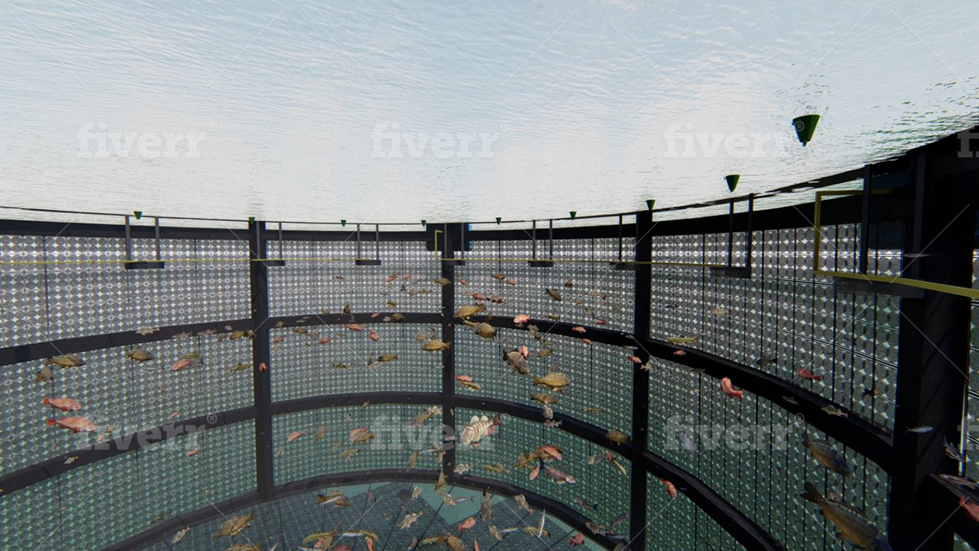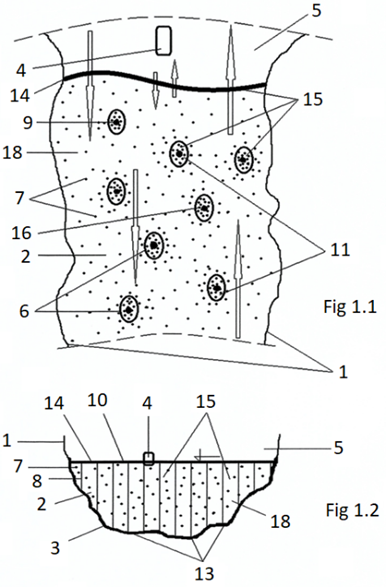FISHERIES IN NATURAL CONDITIONS
The current technology of fish farming is mainly based on the technology of smaller fisheries, or the use of cages for fish farming in the open habitat. The current technology for fish farming has not solved how to feed fish efficiently. With our technology, almost all the shortcomings are completely solved, and the application of additional feeding technology in the process of fish self-service.
In open waters, fish are now raised in cages. It is an expensive and limited space, where conditions favor the development of pathogenic factors. Substantial material resources are spent on average fish farming, with additional chemical treatment to keep it in such inhumane living conditions. The new solution predicts the use of the open sea or a natural pool with water, the use of a fjord or a bay, an artificial lake which is an integral part of the existing hydroelectric power plant. The new solution involves open water surfaces where there is water flow, tidal action and sufficient flowing water in the river. By using the existing places where a functional network of rings would be set up as a barrier, we get everything we need to get spacious ponds. Fish would be raised in large quantities, fed through ecosystems and supplemented with the help of our feeders.

The barrier must be strong enough, with many openings that mostly cover the surface of the barrier. For example, with concentric circles or interconnected rings of corresponding smaller and larger dimensions. Then we get openings for the free passage of small animals, plankton and other nutrients from the sea, everything necessary for the natural nutrition of fish. This method stops the passage of large fish, such as sharks. Unlike classic nets, this type of barrier is harmless to sea animals. For example, turtles and fish that cannot be attached to a canvas with concentric circles, because there is no technical place where it is possible to catch the fins or limbs of a turtle. An example of an innovative floating fishery is shown in the picture above.
The fishery is located in a bay, accumulation lake or part of the river in a way that is surrounded by a barrier, where a larger volume of water for fish farming is set aside. The barrier is placed at the entrance to the bay, or a part of the shore is separated by it. Above the barrier, under technical conditions, boats for feeding and catching consumer fish can sail. The barrier consists of a net with rings, attached to the bottom with concrete anchors. Concrete anchors are interconnected by cables. The barrier at the other end is attached to air-filled chambers, a structure with Styrofoam that floats freely in the water level. In places of lattice-connected cables, brackets for positioning the net with circular or elliptical openings are positioned.
 New feeders are placed in the fishery as needed. The feeders are attached to buoys that are at water level, the lower part anchored over the cable to the bottom of the sea, lake, river or existing fishery. Feeders work on the principle of a platform, located below the water level. Food for several days needs is stored in the feeder, and the fish is regularly self-serving by dosing from buoys. The buoys additionally serve as a food silo. In this way, fish without excessive stress, protected from predators, regularly consume food.
New feeders are placed in the fishery as needed. The feeders are attached to buoys that are at water level, the lower part anchored over the cable to the bottom of the sea, lake, river or existing fishery. Feeders work on the principle of a platform, located below the water level. Food for several days needs is stored in the feeder, and the fish is regularly self-serving by dosing from buoys. The buoys additionally serve as a food silo. In this way, fish without excessive stress, protected from predators, regularly consume food.
Fig. 1.1 shows a top view of the bay 5 with a possible barrier and numerous feeders 6, all in accordance with the invention and for the purpose of forming a mega pond 2. The barrier is made of net with rings 15, details of which have already been described. The barrier is placed on cables, connecting the two shores of Bay 1 and is laid vertically in relation to the water level to the bottom of the bay. The barrier is secured and positioned for the bottom with the help of anchors made of concrete. Ring net 15 is made mainly with circular or elliptical openings. The openings allow free flow of water and the passage of small animals, while stopping the passage of fish 7 from fishery 2 to the outside environment. Predators are not allowed to enter the pond 2.
The cross section of the bay is shown in Fig. 1.2, where the net with the rings 15 is placed on the chambers 14 filled with air. The net with the rings 15 is located from the water level 10 to the bottom of the bay 3. Part of the bay 5 in this way becomes a naturally arranged fishery 2, in which a large number of feeders 6 are located and arranged. The feeder 6 is attached to a buoy 9 which is located at the water level 10. The platform of the feeder 11 is positioned at the projected depth, the fish 7 is then freely fed by self-service. The operation signaling and control device 16 monitors and performs all the necessary operation functions, as previously described.
-
EXISTING TECHNOLOGY IN FISHERIES INNOVATIVE TECHNOLOGY IN FISHERIES Limited space for fish farming. With thick planting, bad conditions are created for the fish to stay. Fish are susceptible to infections and parasites. Innovation is making revolutionary progress in fish farming. The possibility of its commercial expansion is unlimited. The fish are allowed to stay similar to natural conditions. Intensive feeding of fish is now being done. The fish contains a lot of fat deposits. Food in the water is wasted uncontrollably, which creates unnecessary economic losses. It is estimated that the new fisheries will have more than 30% better economic indicators in fish fattening. The fish will be self-serving periodically on the feeder. This way of eating achieves high quality fish, without excess fat deposits. Fish do not lose energy to strengthen immunity and recover from infection. It stays in the fisheries without stress, since it is protected from predators. Today’s technology has not solved fisheries on the high seas, related to the protection of fish from predators, such as sharks or tuna. There are openings in the pond network through which fish pass uncontrollably. Fish is 100% protected from predators, sharks, tuna, dolphins, whales, birds and other natural enemies. It is 100% certain that we will catch the farmed fish. Today, fisheries are limited by the amount of fish farming, but not by the large workforce that serves them. Innovative fisheries on the high seas are made of 100 tons, 1,000 tons and 50,000 tons, where their work is monitored by sensors, automation and robotics without the presence of man. The man is a controller, he fills the silos twice a month with food and granules with various medicines in case of need. The problem of diseased fish is solved in the beginning, preventively. Standing water, or partly running water, is now working on machines to enrich the water with oxygen, so that the fish can survive. The construction of the fishery and the place of installation is such that the pond oscillates and enables a constant flow of water through it. Fresh water brings oxygen and removes polluted water from the fishery. This is a natural cycle. Commercial catches are not profitable. With a large workforce, hunting is not selective. Small and large fish are caught seasonally. Hunting is automated without the presence of a man. It is convenient to use when the fish is calibrated. In this way, only 5 kg or 8 kg fish are caught, as needed. When the fish reaches the required size, it is automatically caught. Tax revenues are not defined, neither the regulations on the protection of young fish. The tax cash register with sensors records the catch, which is later used to finance projects for the sustainable development of fisheries. Young fish are protected from being caught. Insufficient development of fisheries is destroying the existing ecosystem. The solution is to restore the ecosystem. With artificial fish farming, there will be enough food for humanity. Fish will be the main source of meat in the future due to lower emissions of carbon dioxide into the atmosphere, due to intensive farming compared to livestock. In 20 years, the demand for food will be 70% higher, and this can be achieved with this revolutionary technology. Fish of different ages are caught. Fish of the same age, weight and quality are caught, as fish from natural conditions, which enables a good selling price. The machines that process and fillet the fish are set to the same values. The packaging of fish fillets is identical, which is good for transport and for shelves in stores. All this enables the highest standard of fish breeding, processing and distribution to consumers, green production technology. Food is mostly wasted, underused. Innovative feeders are underwater platforms, which periodically feed fish and food is consumed 100%. The fish eats the food on its own within 10 minutes, stays in good shape with a regular diet and is not exposed to additional stress.


